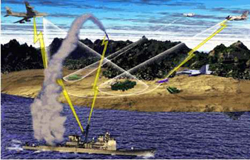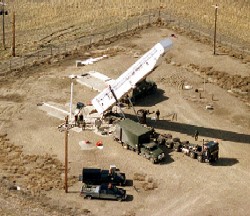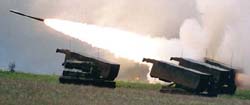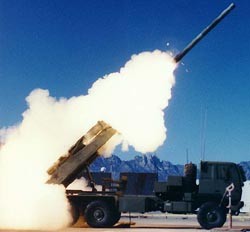Daily News
by Gail Helmer
[ Send Us News | Archives ]
WWII Online Offers Free Play
Since its launch in June 2001, World War II Online has been fighting an uphill battle of upgrades, patches, server problems, bad press and lack of paying members. With the recent rumor that Playnet had filed Chapter 11, attempts to boost WWII Online membership are being made. Yesterday, Playnet and Cornered Rat Software announced a new "Re-evaluation Program". The new program allows all former accounts, which were closed prior to January 6th, 2002, to be re-activated for access to the game and forums. The accounts will be re-activated starting at approximately 1700CT Friday, January 11th and ending January 25th. [More...]
Military News
Boeing, SAIC Team For Next Future Combat Systems Phase
Boeing and Science Applications International Corp. (SAIC), who competed as separate teams for Phase One of the Army's Future Combat Systems (FCS) programme, are to join forces as the programme moves to the next stage of development.
FCS is a networked system-of-systems, set to form the backbone of the Army's long-term transition plan to reach what they call the "objective force". It is designed to serve as the core building block to develop the combat power, sustainability, and versatility necessary for full spectrum military operations. The Army transformation requirements are for a mobile force, which includes the capability to put a combat-capable brigade anywhere in the world within 96 hours, a full division in 120 hours, and five divisions on the ground within 30 days.
Phantom Works and the Space and Communications business unit are to jointly lead the effort for Boeing. They are building on the company's large-scale systems integration experience to provide the lead system integration (LSI) expertise being sought by DARPA and the Army, the procuring agencies for FCS.
"I think that we have an excellent understanding of the complexities - and challenges - of a large system-of-systems such as the Future Combat Systems," said Ron Prosser, Vice President Advanced Space & Communications.
"SAIC brings a team of experienced senior engineers and scientists with strong DARPA and Army programmatic experience and expertise that is critical to the FCS program," said John Gully, SAIC corporate vice president, who led SAIC's Phase One team.
Northrop Grumman Awarded AMSTE Contract
Northrop Grumman Corporation was recently awarded a $22.9 million cost-plus-award-fee contract to demonstrate the next phase of the Defense Advanced Research Projects Agency's (DARPA) Affordable Moving Surface Target Engagement (AMSTE) program. The company's Integrated Systems sector was selected in September 2001 for this phase following an earlier demonstration completion.
The project is funded by the DARPA Information Exploitation Office in conjunction with the contracting activity, the U.S. Air Force Research Laboratory in Rome, N.Y. Northrop Grumman Integrated Systems' Airborne Ground Surveillance and Battle Management (AGS&BM) Systems business area here will develop, integrate and demonstrate system technologies required for precision engagement of moving surface threats from long range. The work is scheduled to be completed in November 2002.

"The success we had in the earlier AMSTE phase demonstrates our commitment to developing and integrating cost-effective system of systems solutions," said Alan Doshier, sector vice president AGS&BM Systems. "Integrating surveillance, reconnaissance and strike platforms give the warfighter real-time solutions for effectively stopping mobile forces."
In August 2001, the Northrop Grumman team successfully demonstrated the capability to precisely engage a moving target with a seekerless weapon. The test, conducted in overcast conditions at Eglin AFB, Fla., scored a direct hit through the top center of a moving vehicle on the first try.
For this next phase, the team will explore employing the Northrop Grumman-developed E-8C Joint Surveillance Target Attack Radar System (Joint STARS), the Global Hawk unmanned platform, the B-2 stealth bomber, and Northrop Grumman Electronic Systems' BAC 1-11 test bed with the F-35 Joint Strike Fighter radar sensor. In addition, the team plans to use the Navy's F/A-18 and airborne P-3 test bed, "Hairy Buffalo," which is equipped with the Northrop Grumman Electronic Systems-developed APY-6 radar. Weapons being considered for the next test include a Joint Direct Attack Munition (JDAM) from The Boeing Company and the newly developed On-target Weapon, Long-range munition from Lockheed Martin Corporation.
ICBM Propulsion Replacement Goes To ATK JV
ATK's Thiokol Propulsion Company and Pratt & Whitney Space and Missile Propulsion have been awarded a one-year contract option worth $191 million from TRW for the US Air Force Minuteman Intercontinental Ballistic Missile (ICBM) System Propulsion Replacement Programme. Under the terms of the joint venture, ATK will receive approximately 60 percent of the total contract value for its work as the lead contractor.

The joint venture will refurbish and remanufacture all three solid propulsion stages of the Minuteman ICBM system. ATK Thiokol Propulsion Company is responsible for demilitarisation of each stage and production of first-stage motors and ordnance systems, while Pratt & Whitney Space and Missile Propulsion will produce the third-stage motors. The two companies will jointly produce the second stage motors.
The contract option, the first for full-rate production, follows a low-rate production programme, which fulfilled all Air Force criteria, including deployment of the first refurbished Minuteman ICBM to an operational silo in 2001.
MLRS Reduced-Range Practice Rockets For USMC, ROK and Egypt
Lockheed Martin Missiles and Fire Control has received a contract for $4 million for Multiple Launch Rocket System (MLRS) Reduced-Range Practice Rocket Pods (RRPRs). The US Marine Corps, the Republic of Korea and Egypt are all purchasing rockets under this contract. Each MLRS RRPR pod contains six ballistic rockets.
"The RRPRs, used in training, have a maximum range of approximately nine miles and a minimum range of about five miles, making it ideal for firing on some of the smaller cannon artillery ranges," said Ron Abbott, Lockheed Martin vice president - Fire Support Programmes. The reduced-range practice rockets also provide for ground impact smoke (rather than air-burst smoke) in the target area. They can be fired from the MLRS M270 and M270A1 launchers and the new High Mobility Artillery Rocket System (HIMARS) launcher.

In 2000, the US Marine Corps joined the HIMARS programme. The Marines will conduct live fires with RRPRs next year as they develop and refine tactics, techniques and procedures. Korea first purchased the MLRS system in 1997, and this year Egypt became the latest country to acquire MLRS.
HIMARS Flight Test Series Successful
Lockheed Martin Missiles and Fire Control have conducted three days of successful flight tests of its High Mobility Artillery Rocket System (HIMARS) as part of the Maturation Test Programme. A total of 12 Multiple Launch Rocket System (MLRS) M28 Practice Rockets were fired successfully from HIMARS at a range of 34 km.
The tests gathered data for the hydraulic control system for adjustment of time between rounds, and for ballistic algorithm development. Forward Looking Infrared Radar (FLIR) data confirmed warhead events in the planned target area. The series of HIMARS flight tests will continue into 2002 with additional missions consisting of single and multiple rocket missile firings at ambient and extreme temperatures.

The HIMARS programme entered the maturation or engineering and manufacturing (EMD) phase in December 1999. In this phase of the programme, six HIMARS launchers will be built for the US Army and two for the US Marine Corps. These launchers will be used for engineering and development testing.
HIMARS is a C-130 transportable, indirect fire, rocket/missile system capable of firing all rockets and missiles in the current and future Multiple Launch Rocket System Family of Munitions (MFOM). It provides 24 hour ground-based, responsive General Support/General Support Reinforcing/Reinforcing (GS/GSR/R) indirect fires, which accurately engage targets at long range with high volumes of lethal fire. The system will extend the range of support provided to warfighting forces from 30 km to 60 km.
[ Send Us News | Archives ]
by Gail Helmer
Wednesday January 09, 2002
- WWII Online Offers Free Play
- Boeing, SAIC Team For Next Future Combat Systems Phase
- Northrop Grumman Awarded AMSTE Contract
- ICBM Propulsion Replacement Goes To ATK JV
- MLRS Reduced-Range Practice Rockets For USMC, ROK and Egypt
- HIMARS Flight Test Series Successful
WWII Online Offers Free Play
Since its launch in June 2001, World War II Online has been fighting an uphill battle of upgrades, patches, server problems, bad press and lack of paying members. With the recent rumor that Playnet had filed Chapter 11, attempts to boost WWII Online membership are being made. Yesterday, Playnet and Cornered Rat Software announced a new "Re-evaluation Program". The new program allows all former accounts, which were closed prior to January 6th, 2002, to be re-activated for access to the game and forums. The accounts will be re-activated starting at approximately 1700CT Friday, January 11th and ending January 25th. [More...]
Military News
Boeing, SAIC Team For Next Future Combat Systems Phase
Boeing and Science Applications International Corp. (SAIC), who competed as separate teams for Phase One of the Army's Future Combat Systems (FCS) programme, are to join forces as the programme moves to the next stage of development.
FCS is a networked system-of-systems, set to form the backbone of the Army's long-term transition plan to reach what they call the "objective force". It is designed to serve as the core building block to develop the combat power, sustainability, and versatility necessary for full spectrum military operations. The Army transformation requirements are for a mobile force, which includes the capability to put a combat-capable brigade anywhere in the world within 96 hours, a full division in 120 hours, and five divisions on the ground within 30 days.
Phantom Works and the Space and Communications business unit are to jointly lead the effort for Boeing. They are building on the company's large-scale systems integration experience to provide the lead system integration (LSI) expertise being sought by DARPA and the Army, the procuring agencies for FCS.
"I think that we have an excellent understanding of the complexities - and challenges - of a large system-of-systems such as the Future Combat Systems," said Ron Prosser, Vice President Advanced Space & Communications.
"SAIC brings a team of experienced senior engineers and scientists with strong DARPA and Army programmatic experience and expertise that is critical to the FCS program," said John Gully, SAIC corporate vice president, who led SAIC's Phase One team.
Northrop Grumman Awarded AMSTE Contract
Northrop Grumman Corporation was recently awarded a $22.9 million cost-plus-award-fee contract to demonstrate the next phase of the Defense Advanced Research Projects Agency's (DARPA) Affordable Moving Surface Target Engagement (AMSTE) program. The company's Integrated Systems sector was selected in September 2001 for this phase following an earlier demonstration completion.
The project is funded by the DARPA Information Exploitation Office in conjunction with the contracting activity, the U.S. Air Force Research Laboratory in Rome, N.Y. Northrop Grumman Integrated Systems' Airborne Ground Surveillance and Battle Management (AGS&BM) Systems business area here will develop, integrate and demonstrate system technologies required for precision engagement of moving surface threats from long range. The work is scheduled to be completed in November 2002.

"The success we had in the earlier AMSTE phase demonstrates our commitment to developing and integrating cost-effective system of systems solutions," said Alan Doshier, sector vice president AGS&BM Systems. "Integrating surveillance, reconnaissance and strike platforms give the warfighter real-time solutions for effectively stopping mobile forces."
In August 2001, the Northrop Grumman team successfully demonstrated the capability to precisely engage a moving target with a seekerless weapon. The test, conducted in overcast conditions at Eglin AFB, Fla., scored a direct hit through the top center of a moving vehicle on the first try.
For this next phase, the team will explore employing the Northrop Grumman-developed E-8C Joint Surveillance Target Attack Radar System (Joint STARS), the Global Hawk unmanned platform, the B-2 stealth bomber, and Northrop Grumman Electronic Systems' BAC 1-11 test bed with the F-35 Joint Strike Fighter radar sensor. In addition, the team plans to use the Navy's F/A-18 and airborne P-3 test bed, "Hairy Buffalo," which is equipped with the Northrop Grumman Electronic Systems-developed APY-6 radar. Weapons being considered for the next test include a Joint Direct Attack Munition (JDAM) from The Boeing Company and the newly developed On-target Weapon, Long-range munition from Lockheed Martin Corporation.
ICBM Propulsion Replacement Goes To ATK JV
ATK's Thiokol Propulsion Company and Pratt & Whitney Space and Missile Propulsion have been awarded a one-year contract option worth $191 million from TRW for the US Air Force Minuteman Intercontinental Ballistic Missile (ICBM) System Propulsion Replacement Programme. Under the terms of the joint venture, ATK will receive approximately 60 percent of the total contract value for its work as the lead contractor.

The joint venture will refurbish and remanufacture all three solid propulsion stages of the Minuteman ICBM system. ATK Thiokol Propulsion Company is responsible for demilitarisation of each stage and production of first-stage motors and ordnance systems, while Pratt & Whitney Space and Missile Propulsion will produce the third-stage motors. The two companies will jointly produce the second stage motors.
The contract option, the first for full-rate production, follows a low-rate production programme, which fulfilled all Air Force criteria, including deployment of the first refurbished Minuteman ICBM to an operational silo in 2001.
MLRS Reduced-Range Practice Rockets For USMC, ROK and Egypt
Lockheed Martin Missiles and Fire Control has received a contract for $4 million for Multiple Launch Rocket System (MLRS) Reduced-Range Practice Rocket Pods (RRPRs). The US Marine Corps, the Republic of Korea and Egypt are all purchasing rockets under this contract. Each MLRS RRPR pod contains six ballistic rockets.
"The RRPRs, used in training, have a maximum range of approximately nine miles and a minimum range of about five miles, making it ideal for firing on some of the smaller cannon artillery ranges," said Ron Abbott, Lockheed Martin vice president - Fire Support Programmes. The reduced-range practice rockets also provide for ground impact smoke (rather than air-burst smoke) in the target area. They can be fired from the MLRS M270 and M270A1 launchers and the new High Mobility Artillery Rocket System (HIMARS) launcher.

In 2000, the US Marine Corps joined the HIMARS programme. The Marines will conduct live fires with RRPRs next year as they develop and refine tactics, techniques and procedures. Korea first purchased the MLRS system in 1997, and this year Egypt became the latest country to acquire MLRS.
HIMARS Flight Test Series Successful
Lockheed Martin Missiles and Fire Control have conducted three days of successful flight tests of its High Mobility Artillery Rocket System (HIMARS) as part of the Maturation Test Programme. A total of 12 Multiple Launch Rocket System (MLRS) M28 Practice Rockets were fired successfully from HIMARS at a range of 34 km.
The tests gathered data for the hydraulic control system for adjustment of time between rounds, and for ballistic algorithm development. Forward Looking Infrared Radar (FLIR) data confirmed warhead events in the planned target area. The series of HIMARS flight tests will continue into 2002 with additional missions consisting of single and multiple rocket missile firings at ambient and extreme temperatures.
The HIMARS programme entered the maturation or engineering and manufacturing (EMD) phase in December 1999. In this phase of the programme, six HIMARS launchers will be built for the US Army and two for the US Marine Corps. These launchers will be used for engineering and development testing.
HIMARS is a C-130 transportable, indirect fire, rocket/missile system capable of firing all rockets and missiles in the current and future Multiple Launch Rocket System Family of Munitions (MFOM). It provides 24 hour ground-based, responsive General Support/General Support Reinforcing/Reinforcing (GS/GSR/R) indirect fires, which accurately engage targets at long range with high volumes of lethal fire. The system will extend the range of support provided to warfighting forces from 30 km to 60 km.
